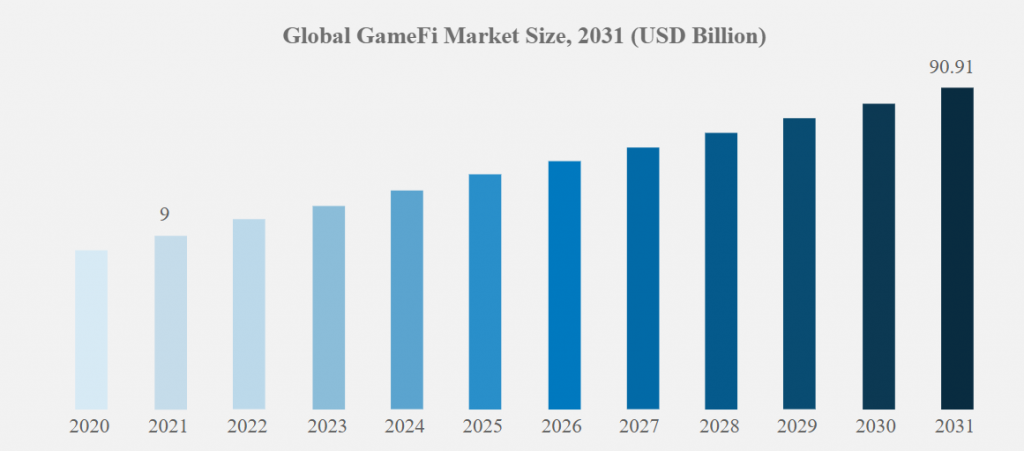The gaming industry has expanded rapidly since the early 2000s, progressing from simple 8-bit video games to enormous open-world multiplayer experiences. In 2023, gaming will be one of the major worldwide entertainment sectors, worth over $200 billion. However, as technology progresses, new horizons in gaming arise.

Source: Fortune business insights
The combination of decentralized technology, blockchain, and the play-to-earn (P2E) economy has paved the way for a new wave of innovation known as GameFi. The Decentralized Physical Infrastructure Network (DePIN) is a critical component of this revolution, providing the infrastructure that drives Web3 game ecosystems.
In this article, we will examine DePIN, its place in the Web3 gaming scene, and why it is primed to cause a major upheaval in the game industry. We’ll also discuss the top five reasons why DePIN is supporting the game industry boom, backed up by statistics and trends from the GameFi and Web3 gaming communities.
What is DePIN?
DePIN, or Decentralized Physical Infrastructure Network, is a network that aims to decentralize physical infrastructure. DePIN uses blockchain technology and smart contracts to ensure that physical components, such as hardware, servers, and even communication networks, are decentralized rather than being controlled by a single body. By reducing central control, decentralization improves security, reduces operating costs, and promotes innovation.
While DePIN is relevant to a variety of industries (including telecommunications and transportation), its influence on the gambling industry has been particularly significant. Traditional gaming is based on centralized servers and infrastructure, which causes congestion, and expensive costs, and frequently results in censorship or limited access to game assets for users. DePIN provides an alternative in which players and developers may collaborate in a more decentralized, democratic gaming environment.
The Shift: From Traditional Gaming to Play-to-Earn
The conventional gaming business follows a straightforward economic model: creators create the game, and users pay for access through sales or subscriptions. Despite investing hundreds or thousands of dollars, players have little to no ownership over in-game assets. Enter play-to-earn gaming, which turns the business on its head.
With the emergence of blockchain-based gaming and GameFi, users may now earn real-world value for their gaming time. NFTs (Non-Fungible Tokens) let users own and exchange in-game assets, including characters, weapons, and skins, for cryptocurrency. This enables a circular economy in which both creators and gamers gain. The worldwide GameFi market was valued at $9 billion in 2021 and is predicted to exceed $90.51 billion by 2031, as millions of gamers adopt the new P2E model.

Source: Business research insights
However, as the popularity of Web3 games grows, so does the demand for greater infrastructure. DePIN does this by decentralizing the physical infrastructure required for these games to function, providing both players and developers greater freedom over the gaming experience.
How does DePIN integrate with Web3 Games?
Web3 games are inherently decentralized since they use blockchain technology to govern transactions, smart contracts, and the in-game economy. DePIN fits well into this ecosystem, offering the essential decentralized infrastructure for games to scale without relying on centralized institutions.
Server failures, bottlenecks, and security issues are common in conventional gaming due to the centralized structure of game hosting. DePIN addresses these difficulties by distributing computational and storage workloads over a worldwide, decentralized network of nodes. Players can connect to many nodes, ensuring that the game remains functioning even if a portion of the network breaks. In addition, DePIN provides options for unique gaming dynamics, such as cross-game economies or interoperable NFTs, where assets from one game can be used in another.
Benefits of DePIN for Gaming
The integration of DePIN into the gaming industry provides several benefits to both developers and players. Here are several significant advantages:
Decentralization and Ownership: With DePIN, players may genuinely own the assets they acquire in-game, as no central body can change or cancel them.
Enhanced Security: By decentralizing infrastructure, DePIN reduces risks such as DDoS assaults and single points of failure, resulting in a more stable and safe gaming experience.
Interoperability: Assets in Web3 games are frequently transportable between games. DePIN enables this with its decentralized architecture, which is cross-platform compatible.
Cost Efficiency: DePIN eliminates the need for costly centralized servers, lowering operating expenses for developers, which may then be passed on to players in the form of lower fees or improved in-game rewards.
Scalability: Because DePIN is decentralized, games can expand more readily, as nodes may be added to the network internationally without requiring large capital investments.
Top 5 Reasons Why DePIN is Enabling a Game Industry Explosion
Empowering True Asset Ownership
DePIN’s connection with Web3 assures that users control the assets they earn or purchase in-game. Unlike traditional games, in which assets are locked within the game’s environment and owned by the developer, DePIN-powered GameFi ecosystems provide transparent, real-time asset ownership. These assets, usually in the form of NFTs, can be exchanged, sold, or even moved across games. This provides players unparalleled control over their in-game investments and has the potential to open new sources of revenue.
For example, in games like Axie Infinity, players may breed, trade, and sell their Axies (NFT-based animals) for real-world value, owing to the decentralized infrastructure that secures true asset ownership.
A Decentralized Economy That Works
DePIN projects establish a decentralized economy in which gamers and developers collaborate in a mutually beneficial relationship. The game is created by developers, who also define the initial parameters for the in-game economy. However, when the game is launched, the economy becomes more player-driven. DePIN enables players to stake tokens, vote on governance problems, and potentially influence the creation of future game features via decentralized autonomous organizations (DAOs).
For example, The Sandbox is a blockchain-powered metaverse in which people may purchase, create, and monetize pieces of land. DePIN enables players to engage in this economy without relying on centralized structures.
Streamlined Cross-Game Asset Transfer
One of the most interesting aspects of DePIN-powered GameFi is the possibility of interoperable assets. DePIN’s decentralized, standardized infrastructure allows players to transfer items, characters, and even currency from one game to another. This minimizes friction for gamers and allows game creators to design more complex, linked gaming universes.
Games in the Polygon ecosystem, where NFTs and tokens may be transferred between numerous games and platforms, are an excellent example of cross-game asset use.
Lower operational costs for developers
One of the most significant issues for game creators is the expense of maintaining large-scale servers and infrastructure. DePIN eliminates the requirement for centralized infrastructure and replaces it with a decentralized network of nodes. This lowers server maintenance expenses and transfers the load of infrastructure management to a dispersed network. Lower operating expenses enable developers to focus more on game creation and less on infrastructure administration, resulting in shorter development cycles and more inventive gameplay features.
Many blockchain-based games, such as Gala Games, are lowering their overhead costs by utilizing decentralized infrastructure for hosting and gaming.
Improved Player Security and Privacy
In conventional gaming, data breaches, hacking attempts, and DDoS assaults may have disastrous effects for both creators and users. DePIN’s decentralization of infrastructure greatly reduces the danger of such assaults. Even if one node is hacked, the game will continue to operate normally on the remaining nodes. Furthermore, blockchain’s transparency and immutability safeguard the security of players’ assets and transactions, bringing peace of mind to both casual and professional gamers.
Web3 games, like Illuvium, shield players from assaults that may jeopardize their precious NFTs and tokens since the infrastructure is decentralized and safe.
Closing Thoughts
The integration of DePIN into the game industry is changing the way we play, interact, and earn in digital environments. As the world transitions to Web3 and decentralized technologies, DePIN guarantees that gaming becomes not only more decentralized and democratic, but also more safe, scalable, and commercially feasible for both developers and gamers.
With true asset ownership, decentralized economics, cross-game interoperability, lower operating costs, and improved security, DePIN is poised to ignite the gaming industry, providing new opportunities for all involved. The future of gaming is decentralized, and DePIN is at the forefront of this transformation, ushering in a new age of GameFi infrastructure in which users own their gaming experiences.




